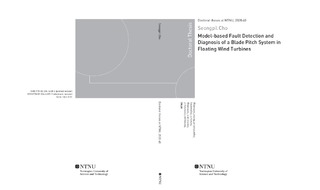| dc.contributor.advisor | Moan, Torgeir | |
| dc.contributor.advisor | Gao, Zhen | |
| dc.contributor.author | Cho, Seongpil | |
| dc.date.accessioned | 2020-02-21T12:05:41Z | |
| dc.date.available | 2020-02-21T12:05:41Z | |
| dc.date.issued | 2020 | |
| dc.identifier.isbn | 978-82-326-4439-1 | |
| dc.identifier.issn | 1503-8181 | |
| dc.identifier.uri | http://hdl.handle.net/11250/2643223 | |
| dc.description.abstract | Offshore wind turbines operate in ocean environments with irregular waves and turbulent winds and experience technical faults during their service life. Faults and failures in their actuators, sensors, and system components could lead to system interruptions. These faults change the system characteristics, the efficiency of power production, and the operational safety. Therefore, fault detection, diagnosis and accommodation techniques are required to ensure the reliability and lower the repair costs of floating wind turbines. Among wind turbine components, the blade pitch system is one of the most critical components due to its effect on the operational safety and the dynamics of wind turbines. In addition, this subsystem has the highest failure rate.
This thesis presents model-based fault detection, fault diagnosis, and fault-tolerant control schemes for blade pitch systems in a spar-type floating wind turbine. Early-stage fault detection and diagnosis should be conducted to prevent escalation of faults and failures. To detect faults of blade pitch systems, a discrete-time Kalman filter is designed to estimate the states of the blade pitch angle of the system. Residuals are generated by a Kalman filter and a threshold based on H∞ optimization, and a linear matrix inequality (LMI) is used for residual evaluation. The fault diagnosis algorithm is based on inference methods under specific fault conditions. Another fault diagnosis scheme uses an artificial neural network and is capable of determining the fault type, location, magnitude and time. For fault detection and diagnosis, the blade pitch angle and valve spool position are measured. Fault diagnosis algorithms can be used for both condition monitoring and active fault-tolerant control purposes. The fault-tolerant controller based on a reconfiguration block with a virtual sensor and a shutdown mode controls the floating wind turbine to avoid unexpected external loads.
Numerical simulations are based on detailed numerical models for the blade pitch actuators coupled to the global analysis model and models of various faults. The proposed methods are demonstrated in case studies simulated using Simo-Riflex, which is an aerohydro-servo-elastic simulation tool with stochastic wind and wave conditions that considers different types of faults, such as biases and fixed outputs in pitch sensors, excessive friction and wrong voltage, or slit-lock or short circuits of valves in pitch actuators. These faults contribute to imbalance rotation in the rotor, which results in different effects on the turbine structure and the platform motion. The proposed method for combining the global and hydraulic actuator models is demonstrated in case studies under stochastic wind and wave conditions and different types of faults in pitch sensors and actuators. The simulation results show that the proposed methods can effectively detect and diagnose faults at an early stage with reasonable accuracy. Additionally, the effectiveness of the fault-tolerant control systems for different load cases for single and multiple fault conditions is verified by numerical simulations | nb_NO |
| dc.language.iso | eng | nb_NO |
| dc.publisher | NTNU | nb_NO |
| dc.relation.ispartofseries | Doctoral theses at NTNU;2020:40 | |
| dc.relation.haspart | Paper 1: Cho, Seongpil; Gao, Zhen; Moan, Torgeir. Model-based fault detection of blade pitch system in floating wind turbines. Journal of Physics: Conference Series 2016 ;Volum 753
https://doi.org/10.1088/1742-6596/753/9/092012
(CC BY 3.0) | nb_NO |
| dc.relation.haspart | Paper 2: Cho, Seongpil; Gao, Zhen; Moan, Torgeir. Model-based Fault Detection, Fault Isolation and Fault-tolerant Control of a Blade Pitch System in Floating Wind Turbines. Renewable Energy 2018 ;Volum 120. s. 306-321
https://doi.org/10.1016/j.renene.2017.12.102 | nb_NO |
| dc.relation.haspart | Paper 3: Cho, Seongpil; Bachynski, Erin Elizabeth; Rasekhi Nejad, Amir; Gao, Zhen; Moan, Torgeir. Numerical modeling of the hydraulic blade pitch actuator in a spar‐type floating wind turbine considering fault conditions and their effects on global dynamic responses. Wind Energy 2020 ;Volum 23.(2) s. 370-390
https://doi.org/10.1002/we.2438
(CC BY-NC-ND 4.0) | nb_NO |
| dc.relation.haspart | Paper 4:
Cho, Seongpil; Choi, Minjoo; Gao, Zhen; Moan, Torgeir.
Fault detection and diagnosis of a blade pitch system of a spar-type floating wind turbine based on a hybrid approach with a Kalman filter and artificial neural network | nb_NO |
| dc.title | Model-based Fault Detection and Diagnosis of a Blade Pitch System in Floating Wind Turbines | nb_NO |
| dc.type | Doctoral thesis | nb_NO |
| dc.subject.nsi | VDP::Technology: 500::Marine technology: 580 | nb_NO |

